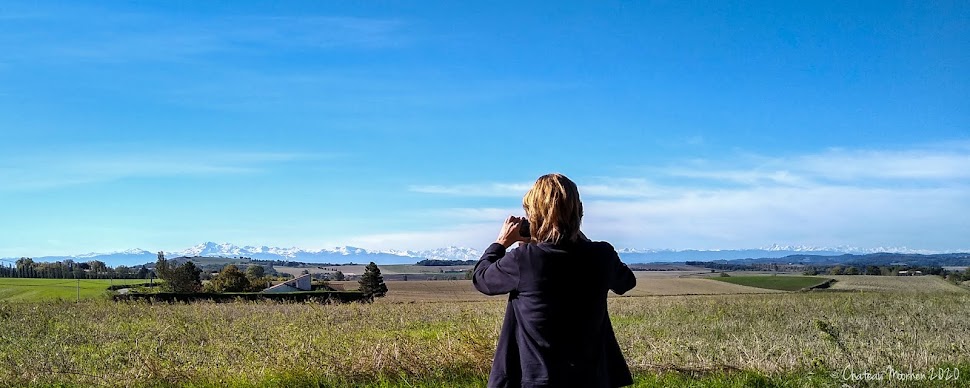This year though, we also have citrus fruits! I have a few fruit slowly growing on my Kaffir Lime tree.
The Meyer Lemon is doing well too and these lemons are already about half size. The flowers are very strongly perfumed and the big blue Carpenter Bees absolutely loved them. I am battling insects on it though - first there was a regular looking scale insect, and now a weird kind of thing I haven't seen before, which I have discovered is Cottony Cushion Scale. The adults grow up to 5mm long and are disgusting to squish 😀 as they are soft and sticky. I've been using Savon Noir which helps to control the pests, and also washes off the sooty mould that is appearing thanks to the honeydew that they excrete. It's a natural product containing soap and olive oil, which I suppose helps make it stick to the leaves and stalks, and seems to be quite effective against unwanted critters.
First real harvest of various tomatoes, peppers and chillies!
We sit out on the patio often in the early evening, even when it is hot (and we have a lovely air conditioned house!) because it’s just nicer being outside. Most evenings the Cirl Bunting comes around - on this particular day he was calling to the female. We were not sure if he was trying to entice her by the juicy grub or whether there were still chicks in a nest that he was going to feed.
I noticed this amazing view so had to grab a camera - whilst we see beautiful sunsets through our kitchen window I've never seen the sky like this before.
Bedding plants around the pool: Fewer geraniums this year to combat the pesky Geranium Bronze butterfly, although I've only seen one of them this summer! But my plan was that if they destroyed the geraniums, I would still have colour around the pool. The Bidens (the orange daisy like flowers) have been magnificent. I also have six Lantanas which I bought from the local nursery, who had sold out of most other plants. 😞 I ended up at the garden centre having to buy more expensive individual geraniums in larger pots as they had sold out of the small ones in trays of six or ten. Next year I will get on to this much sooner - I forget that I am in the south and everyone is buying their bedding much earlier than in Brittany!
This year's colour scheme is hot! Lantana:
Bidens with red Geranium and white Lantana in the background:
I've started collecting plants that I want for my nectar bar bed that hopefully will be created this autumn - as I need a 'helper' 😀 to clear the turf and prep the ground so that I can plant. It's annoying to buy the plants larger like this as the price is ridiculous, but buying them in season is often the only way to be sure of finding the plants that you want, and to be sure of the colours of the flowers. Oh well, at least the bed will look good from next year as some of the plants are quite mature.
There is a lot of watering to do though; often I need to water these plants twice a day as they dry out so quickly.
Lavender, Nepeta, Perovskia and in the foreground, a really lovely purple Sedum called 'Dazzleberry'. The other Sedum in the glazed pot was left here for us! I also have Gaura and yet another Sedum hiding behind the pillar.
Salvia 'Hot Lips' and 'Amethyst Lips':
Next photo - Perovskia, Nepeta and Salvia guaranitica (which I hadn't realised were actually shrubs that grow to about 1.5 metres!). So I will plant these two beauties (the ones at the front) at each end of the bed.
I'm going to add some herbs to this bed, including Rosemary which flowers in the late winter, and bulbs for early spring flowers for the pollinators. Hopefully there will be about 9-10 months' worth of flowers for them. The Perovskia in particular is already covered in buzzy bees nectaring on the blooms. 🐝🐝🐝
The pool looking inviting on a lovely day (that's the robot in there cleaning it - it's just like a robot vacuum!):
We have been enjoying all the fields full of sunflowers around here, and I've been wanting to take photos for weeks, but it's hard to find somewhere to pull over when you are on a main road! Finally we found a place where we could stop, although the flowers were just starting to go over, but there were still some individual heads that were perfect. Honey bees were enjoying the pollen and nectar. I have other photos I will feature in another post later. 😀🌻🌻🌻
The rest of the garden is coming along fine, although I still haven’t seen a butterfly on my new Buddleia. The herb bed has been full of colour and bees enjoying the flowers, which has been great as I can see most of it through the kitchen window. The greengage was so loaded in fruit a few weeks back that I took about six bags around to various neighbours, and met some of them whilst doing so, which was nice. The neighbours whose house we look out over from our kitchen window gave us a bag of tomatoes last week, just at a point when we had no ripe tomatoes ourselves, so that worked out well! Covid has prevented us getting to know anyone around here other than exchanging a bonjour in passing. I still don’t feel like socialising with people I don’t know indoors though. You can't really say "Would you like to come around for a coffee, but you can only come if you've been vaccinated". :-/ Maybe next year.















































